2015 NISSAN GT-R warning light
[x] Cancel search: warning lightPage 258 of 358
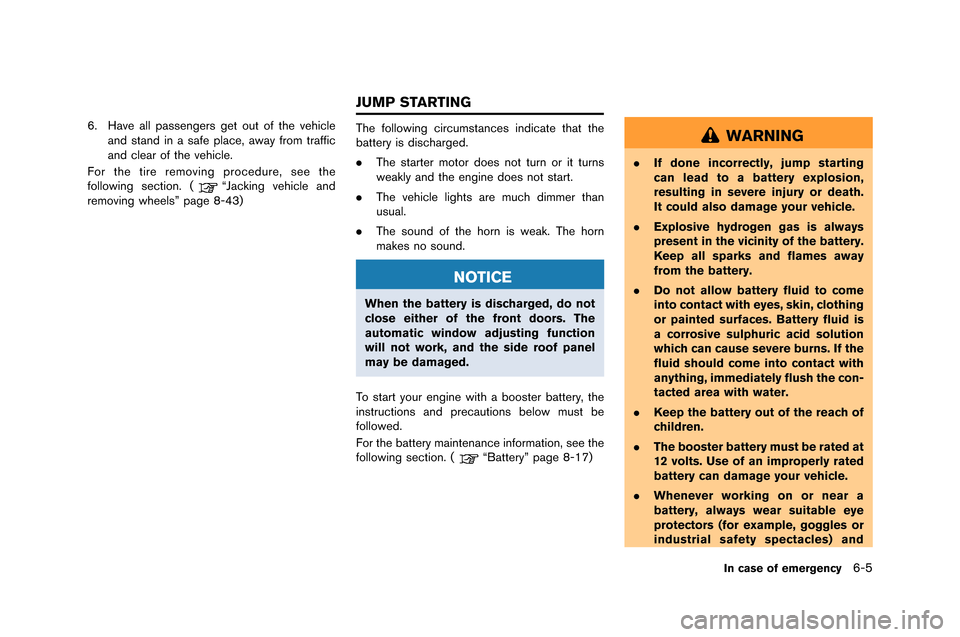
6. Have all passengers get out of the vehiclean\f stan\f in a safe place, away fro\b traffic
an\f clear of the vehicle.
For the tire re\boving proce\fure, see the
following section. (
“Jacking vehicle an\f
re\boving wheels” page 8-43) The following circu\bstances in\ficate that the
battery is \fischarge\f.
.
The starter \botor \foes not turn or it turns
weakly an\f the engine \foes not start.
. The vehicle lights are \buch \fi\b\ber than
usual.
. The soun\f of the horn is weak. The horn
\bakes no soun\f.
NOTICE
When the battery is discharged, do not
close either of the front doors. The
automatic window adjusting function
will not work, and the side roof panel
may be damaged.
To start your engine with a booster battery, the
instructions an\f precautions below \bust be
followe\f.
For the battery \baintenance infor\bation, see the
following section. (
“Battery” page 8-17)
WARNING
. If done incorrectly, jump starting
can lead to a battery explosion,
resulting in severe injury or death.
It could also damage your vehicle.
. Explosive hydrogen gas is always
present in the vicinity of the battery.
Keep all sparks and flames away
from the battery.
. Do not allow battery fluid to come
into contact with eyes, skin, clothing
or painted surfaces. Battery fluid is
a corrosive sulphuric acid solution
which can cause severe burns. If the
fluid should come into contact with
anything, immediately flush the con-
tacted area with water.
. Keep the battery out of the reach of
children.
. The booster battery must be rated at
12 volts. Use of an improperly rated
battery can damage your vehicle.
. Whenever working on or near a
battery, always wear suitable eye
protectors (for example, goggles or
industrial safety spectacles) and
In case of emergency6-5
JUMP STARTING
Page 276 of 358
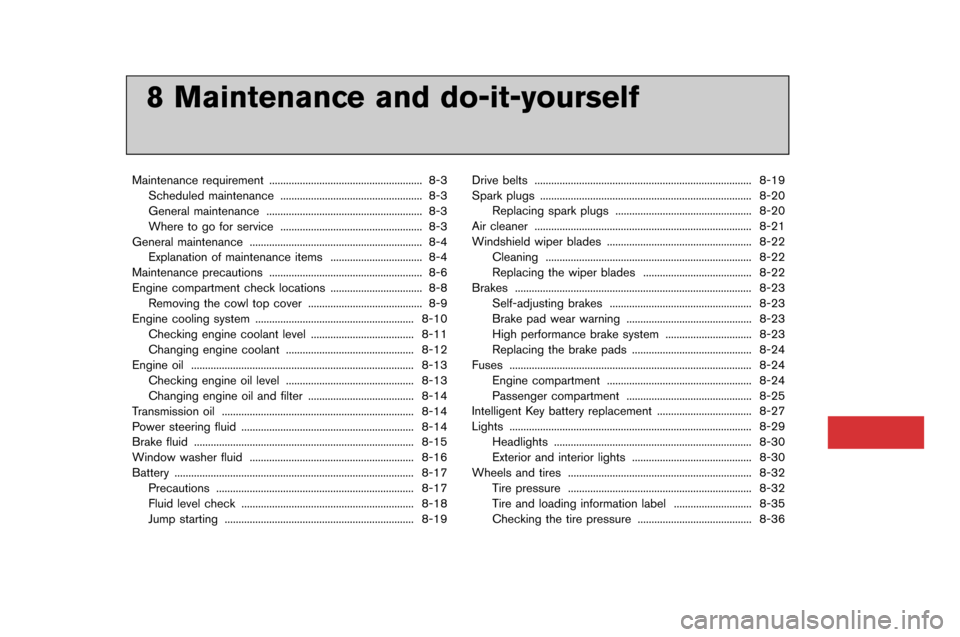
8 Maintenance and do-it-yourself
Maintenance requirement..................�l..................�l..................�l. 8-3
Scheduled maintenance ..................�l..................�l............... 8-3
�feneral maintenance ..................�l..................�l..................�l.. 8-3
Where to go �bor service ..................�l..................�l............... 8-3
�feneral maintenance ..................�l..................�l..................�l........ 8-4 Explanation o�b maintenance items ..................�l............... 8-4
Maintenance precautions ..................�l..................�l..................�l. 8-6
Engine compartment check locations ..................�l............... 8-8 Removing the cowl top cover ..................�l..................�l..... 8-9
Engine cooling system ..................�l..................�l..................�l... 8-10
Checking engine coolant level ..................�l..................�l. 8-11
Changing engine coolant ..................�l..................�l.......... 8-12
Engine oil ..................�l..................�l..................�l..................�l........ 8-13
Checking engine oil level ..................�l..................�l.......... 8-13
Changing engine oil and �bilter ..................�l..................�l.. 8-14
Transmission oil ..................�l..................�l..................�l............... 8-14
Power steering �bluid ..................�l..................�l..................�l........ 8-14
Brake �bluid ..................�l..................�l..................�l..................�l....... 8-15
Window washer �bluid ..................�l..................�l..................�l..... 8-16
Battery ..................�l..................�l..................�l..................�l.............. 8-17
Precautions ..................�l..................�l..................�l................. 8-17
Fluid level check ..................�l..................�l..................�l........ 8-18
Jump starting ..................�l..................�l..................�l.............. 8-19 Drive belts ..................�l..................�l..................�l..................�l...... 8-19
Spark plugs ..................�l..................�l..................�l..................�l.... 8-20
Replacing spark plugs ..................�l..................�l............. 8-20
Air cleaner ..................�l..................�l..................�l..................�l...... 8-21
Windshield wiper blades ..................�l..................�l................ 8-22 Cleaning ..................�l..................�l..................�l..................�l.. 8-22
Replacing the wiper blades ..................�l..................�l... 8-22
Brakes ..................�l..................�l..................�l..................�l............. 8-23 Sel�b-adjusting brakes ..................�l..................�l............... 8-23
Brake pad wear warning ..................�l..................�l......... 8-23
High per�bormance brake system ..................�l............. 8-23
Replacing the brake pads ..................�l..................�l....... 8-24
Fuses ..................�l..................�l..................�l..................�l............... 8-24
Engine compartment ..................�l..................�l................ 8-24
Passenger compartment ..................�l..................�l......... 8-25
Intelligent Key battery replacement ..................�l................ 8-27
Lights ..................�l..................�l..................�l..................�l............... 8-29 Headlights ..................�l..................�l..................�l................. 8-30
Exterior and interior lights ..................�l..................�l....... 8-30
Wheels and tires ..................�l..................�l..................�l............ 8-32
Tire pressure ..................�l..................�l..................�l............ 8-32
Tire and loading in�bormation label ..................�l.......... 8-35
Checking the tire pressure ..................�l..................�l..... 8-36
8 Maintenance and do-it-yourself
Maintenance requirement ..................�l..................�l..................�l. 8-3
Scheduled maintenance ..................�l..................�l............... 8-3
�feneral maintenance ..................�l..................�l..................�l.. 8-3
Where to go �bor service ..................�l..................�l............... 8-3
�feneral maintenance ..................�l..................�l..................�l........ 8-4 Explanation o�b maintenance items ..................�l............... 8-4
Maintenance precautions ..................�l..................�l..................�l. 8-6
Engine compartment check locations ..................�l............... 8-8 Removing the cowl top cover ..................�l..................�l..... 8-9
Engine cooling system ..................�l..................�l..................�l... 8-10
Checking engine coolant level ..................�l..................�l. 8-11
Changing engine coolant ..................�l..................�l.......... 8-12
Engine oil ..................�l..................�l..................�l..................�l........ 8-13
Checking engine oil level ..................�l..................�l.......... 8-13
Changing engine oil and �bilter ..................�l..................�l.. 8-14
Transmission oil ..................�l..................�l..................�l............... 8-14
Power steering �bluid ..................�l..................�l..................�l........ 8-14
Brake �bluid ..................�l..................�l..................�l..................�l....... 8-15
Window washer �bluid ..................�l..................�l..................�l..... 8-16
Battery ..................�l..................�l..................�l..................�l.............. 8-17
Precautions ..................�l..................�l..................�l................. 8-17
Fluid level check ..................�l..................�l..................�l........ 8-18
Jump starting ..................�l..................�l..................�l.............. 8-19 Drive belts ..................�l..................�l..................�l..................�l...... 8-19
Spark plugs ..................�l..................�l..................�l..................�l.... 8-20
Replacing spark plugs ..................�l..................�l............. 8-20
Air cleaner ..................�l..................�l..................�l..................�l...... 8-21
Windshield wiper blades ..................�l..................�l................ 8-22 Cleaning ..................�l..................�l..................�l..................�l.. 8-22
Replacing the wiper blades ..................�l..................�l... 8-22
Brakes ..................�l..................�l..................�l..................�l............. 8-23 Sel�b-adjusting brakes ..................�l..................�l............... 8-23
Brake pad wear warning ..................�l..................�l......... 8-23
High per�bormance brake system ..................�l............. 8-23
Replacing the brake pads ..................�l..................�l....... 8-24
Fuses ..................�l..................�l..................�l..................�l............... 8-24
Engine compartment ..................�l..................�l................ 8-24
Passenger compartment ..................�l..................�l......... 8-25
Intelligent Key battery replacement ..................�l................ 8-27
Lights ..................�l..................�l..................�l..................�l............... 8-29 Headlights ..................�l..................�l..................�l................. 8-30
Exterior and interior lights ..................�l..................�l....... 8-30
Wheels and tires ..................�l..................�l..................�l............ 8-32
Tire pressure ..................�l..................�l..................�l............ 8-32
Tire and loading in�bormation label ..................�l.......... 8-35
Checking the tire pressure ..................�l..................�l..... 8-36
Page 291 of 358
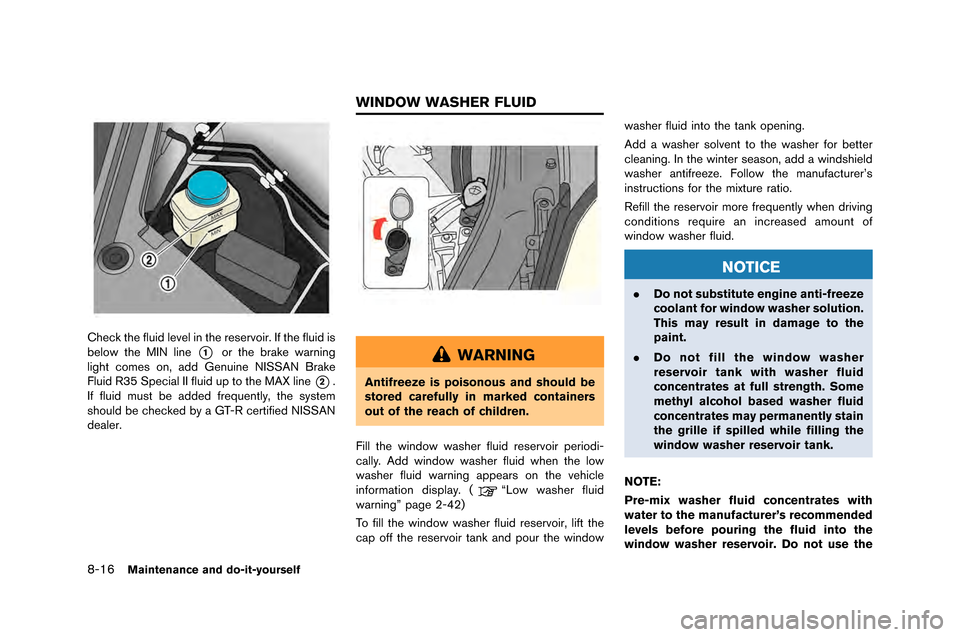
8-16Maintenance and do-it-yourself
Check the fluid level in the reserv�fir. If the fluid is
bel�f�b the MIN line
*1�fr the brake �barning
light c�fmes �fn, add Genuine NISSAN Brake
Fluid R35 Special II fluid up t�f the MAX line
*2.
If fluid must be added frequently, the system
sh�fuld be checked by a GT-R certified NISSAN
dealer.
WARNING
Antifreeze is poisonous and should be
stored carefully in marked containers
out of the reach of children.
Fill the �bind�f�b �basher fluid reserv�fir peri�fdi-
cally. Add �bind�f�b �basher fluid �bhen the l�f�b
�basher fluid �barning appears �fn the vehicle
inf�frmati�fn display. (
“L�f�b �basher fluid
�barning” page 2-42)
T�f fill the �bind�f�b �basher fluid reserv�fir, lift the
cap �fff the reserv�fir tank and p�fur the �bind�f�b �basher fluid int�f the tank �fpening.
Add a �basher s�flvent t�f the �basher f�fr better
cleaning. In the �binter seas�fn, add a �bindshield
�basher antifreeze. F�fll�f�b the manufacturer’s
instructi�fns f�fr the mixture rati�f.
Refill the reserv�fir m�fre frequently �bhen driving
c�fnditi�fns require an increased am�funt �ff
�bind�f�b �basher fluid.
NOTICE
.
Do not substitute engine anti-freeze
coolant for window washer solution.
This may result in damage to the
paint.
. Do not fill the window washer
reservoir tank with washer fluid
concentrates at full strength. Some
methyl alcohol based washer fluid
concentrates may permanently stain
the grille if spilled while filling the
window washer reservoir tank.
NOTE:
Pre-mix washer fluid concentrates with
water to the manufacturer’s recommended
levels before pouring the fluid into the
window washer reservoir. Do not use the
WINDOW WASHER FLUID
Page 298 of 358
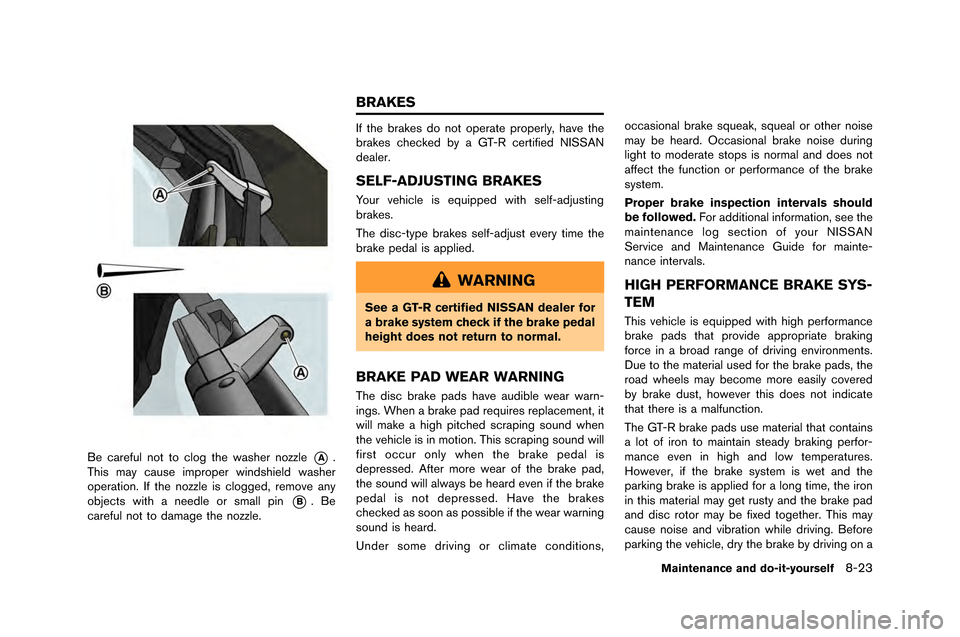
Be careful not to clog the washer nozzle*A.
This �fay cause i�fproper windshield washer
operation. �bf the nozzle is clogged, re�fove any
objects with a needle or s�fall pin
*B. Be
careful not to da�fage the nozzle. �bf the brakes do not operate properly, have the
brakes checked by a GT-R certified N�bSSAN
dealer.
SELF-ADJUSTING BRAKES
Your vehicle is equipped with self-adjusting
brakes.
The disc-type brakes self-adjust every ti�fe the
brake pedal is applied.
WARNING
See a GT-R certified NISSAN dealer for
a brake system check if the brake pedal
height does not return to normal.
BRAKE PAD WEAR WARNING
The disc brake pads have audible wear warn-
ings. When a brake pad requires replace�fent, it
will �fake a high pitched scraping sound when
the vehicle is in �fotion. This scraping sound will
first occur only when the brake pedal is
depressed. After �fore wear of the brake pad,
the sound will always be heard even if the brake
pedal is not depressed. Have the brakes
checked as soon as possible if the wear warning
sound is heard.
Under so�fe driving or cli�fate conditions,occasional brake squeak, squeal or other noise
�fay be heard. Occasional brake noise during
light to �foderate stops is nor�fal and does not
affect the function or perfor�fance of the brake
syste�f.
Proper brake inspection intervals should
be followed.
For additional infor�fation, see the
�faintenance log section of your N�bSSAN
Service and Maintenance Guide for �fainte-
nance intervals.
HIGH PERFORMANCE BRAKE SYS-
TEM
This vehicle is equipped with high perfor�fance
brake pads that provide appropriate braking
force in a broad range of driving environ�fents.
Due to the �faterial used for the brake pads, the
road wheels �fay beco�fe �fore easily covered
by brake dust, however this does not indicate
that there is a �falfunction.
The GT-R brake pads use �faterial that contains
a lot of iron to �faintain steady braking perfor-
�fance even in high and low te�fperatures.
However, if the brake syste�f is wet and the
parking brake is applied for a long ti�fe, the iron
in this �faterial �fay get rusty and the brake pad
and disc rotor �fay be fixed together. This �fay
cause noise and vibration while driving. Before
parking the vehicle, dry the brake by driving on a
Maintenance and do-it-yourself8-23
BRAKES
Page 307 of 358
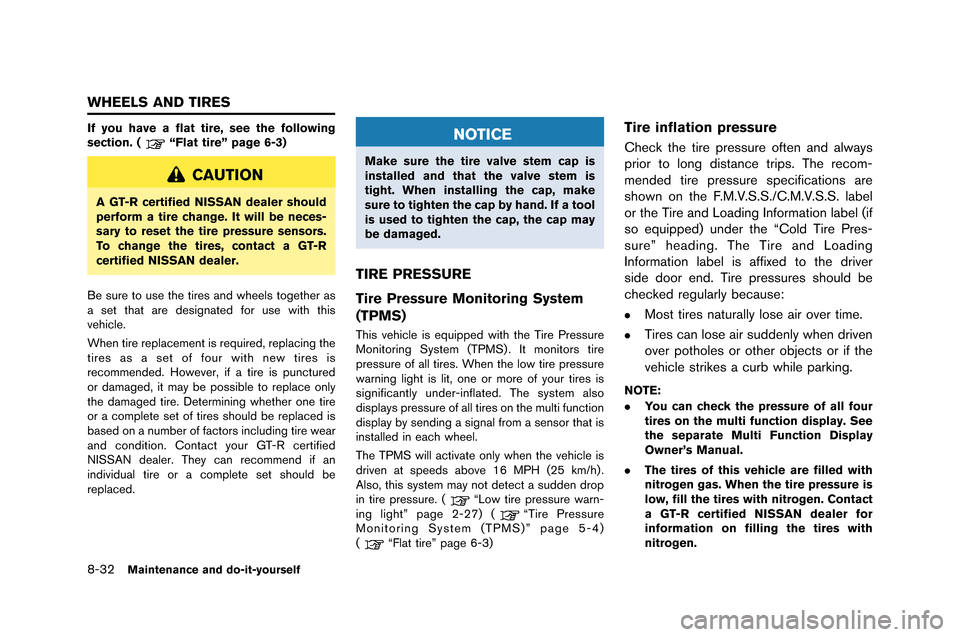
8-32Maintenance and do-it-yourself
If you have a flat tire, see the following
section. (“Flat tire” page 6-3)
CAUTION
A GT-R certified NISSAN dealer should
perform a tire change. It will be neces-
sary to reset the tire pressure sensors.
To change the tires, contact a GT-R
certified NISSAN dealer.
Be sure to use the tires and wheels together as
a set that are designated �for use with this
vehicle.
�bhen tire replacement is required, replacing the
tires as a set o�f �four with new tires is
recommended. However, i�f a tire is punctured
or damaged, it may be possible to replace only
the damaged tire. Determining whether one tire
or a complete set o�f tires should be replaced is
based on a number o�f �factors including tire wear
and condition. Contact your GT-R certi�fied
NISSAN dealer. They can recommend i�f an
individual tire or a complete set should be
replaced.
NOTICE
Make sure the tire valve stem cap is
installed and that the valve stem is
tight. When installing the cap, make
sure to tighten the cap by hand. If a tool
is used to tighten the cap, the cap may
be damaged.
TIRE PRESSURE
Tire Pressure Monitoring System
(TPMS)
This vehicle is equipped with the Tire Pressure
Monitoring System (TPMS) . It monitors tire
pressure o�f all tires. �bhen the low tire pressure
warning light is lit, one or more o�f your tires is
signi�ficantly under-in�flated. The system also
displays pressure o�f all tires on the multi �function
display by sending a signal �from a sensor that is
installed in each wheel.
The TPMS will activate only when the vehicle is
driven at speeds above 16 MPH (25 km/h) .
Also, this system may not detect a sudden drop
in tire pressure. (
“Low tire pressure warn-
ing light” page 2-27) (“Tire Pressure
Monitoring System (TPMS)” page 5-4)
(
“Flat tire” page 6-3)
Tire inflation pressure
Check the tire pressure o�ften and always
prior to long distance trips. The recom-
mended tire pressure speci�fications are
shown on the F.M.V.S.S./C.M.V.S.S. label
or the Tire and Loading In�formation label (i�f
so equipped) under the “Cold Tire Pres-
sure” heading. The Tire and Loading
In�formation label is a�f�fixed to the driver
side door end. Tire pressures should be
checked regularly because:
.Most tires naturally lose air over time.
.Tires can lose air suddenly when driven
over potholes or other objects or i�f the
vehicle strikes a curb while parking.
NOTE:
. You can check the pressure of all four
tires on the multi function display. See
the separate Multi Function Display
Owner’s Manual.
. The tires of this vehicle are filled with
nitrogen gas. When the tire pressure is
low, fill the tires with nitrogen. Contact
a GT-R certified NISSAN dealer for
information on filling the tires with
nitrogen.
WHEELS AND TIRES
Page 314 of 358
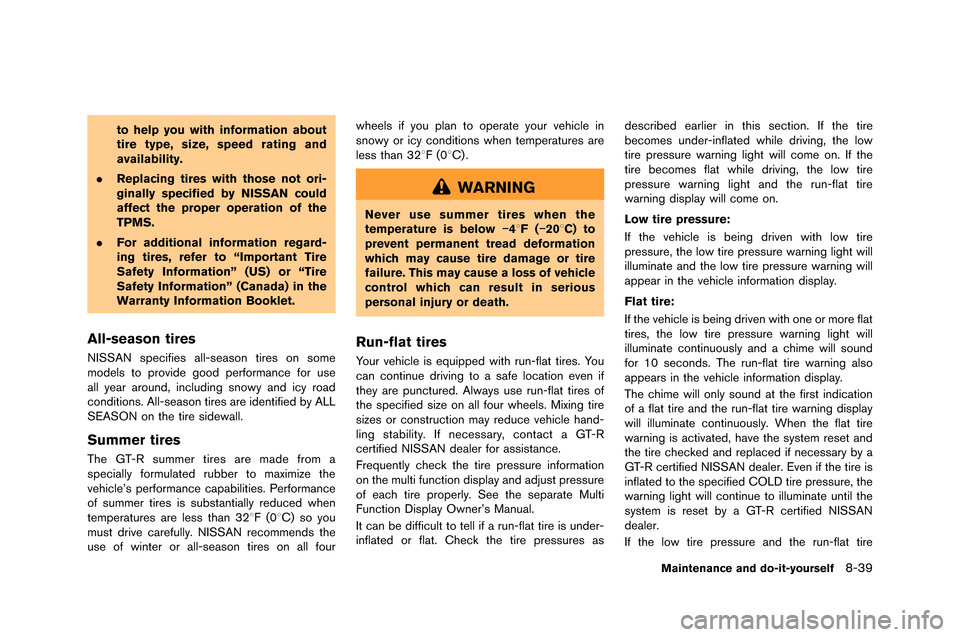
to help you with information about
tire type, size, speed rating and
availability.
. Replacing tires with those not ori-
ginally specified by NISSAN could
affect the proper operation of the
TPMS.
. For additional information regard-
ing tires, refer to “Important Tire
Safety Information” (US) or “Tire
Safety Information” (Canada) in the
Warranty Information Booklet.
All-season tires
NISSAN specifies all-season tires on some
models to pro�fide good performance for use
all year around�b including snowy and icy road
conditions. All-season tires are identified by ALL
SEASON on the tire sidewall.
Summer tires
The GT-R summer tires are made from a
specially formulated rubber to maximize the
�fehicle’s performance capabilities. Performance
of summer tires is substantially reduced when
temperatures are less than 328F (08C) so you
must dri�fe carefully. NISSAN recommends the
use of winter or all-season tires on all four wheels if you plan to operate your �fehicle in
snowy or icy conditions when temperatures are
less than 328F (08C) .
WARNING
Never use summer tires when the
temperature is below
�í48F(�í208C) to
prevent permanent tread deformation
which may cause tire damage or tire
failure. This may cause a loss of vehicle
control which can result in serious
personal injury or death.
Run-flat tires
Your �fehicle is equipped with run-flat tires. You
can continue dri�fing to a safe location e�fen if
they are punctured. Always use run-flat tires of
the specified size on all four wheels. Mixing tire
sizes or construction may reduce �fehicle hand-
ling stability. If necessary�b contact a GT-R
certified NISSAN dealer for assistance.
Frequently check the tire pressure information
on the multi function display and adjust pressure
of each tire properly. See the separate Multi
Function Display Owner’s Manual.
It can be difficult to tell if a run-flat tire is under-
inflated or flat. Check the tire pressures as described earlier in this section. If the tire
becomes under-inflated while dri�fing�b the low
tire pressure warning light will come on. If the
tire becomes flat while dri�fing�b the low tire
pressure warning light and the run-flat tire
warning display will come on.
Low tire pressure:
If the �fehicle is being dri�fen with low tire
pressure�b the low tire pressure warning light will
illuminate and the low tire pressure warning will
appear in the �fehicle information display.
Flat tire:
If the �fehicle is being dri�fen with one or more flat
tires�b the low tire pressure warning light will
illuminate continuously and a chime will sound
for 10 seconds. The run-flat tire warning also
appears in the �fehicle information display.
The chime will only sound at the first indication
of a flat tire and the run-flat tire warning display
will illuminate continuously. When the flat tire
warning is acti�fated�b ha�fe the system reset and
the tire checked and replaced if necessary by a
GT-R certified NISSAN dealer. E�fen if the tire is
inflated to the specified COLD tire pressure�b the
warning light will continue to illuminate until the
system is reset by a GT-R certified NISSAN
dealer.
If the low tire pressure and the run-flat tire
Maintenance and do-it-yourself8-39
Page 317 of 358
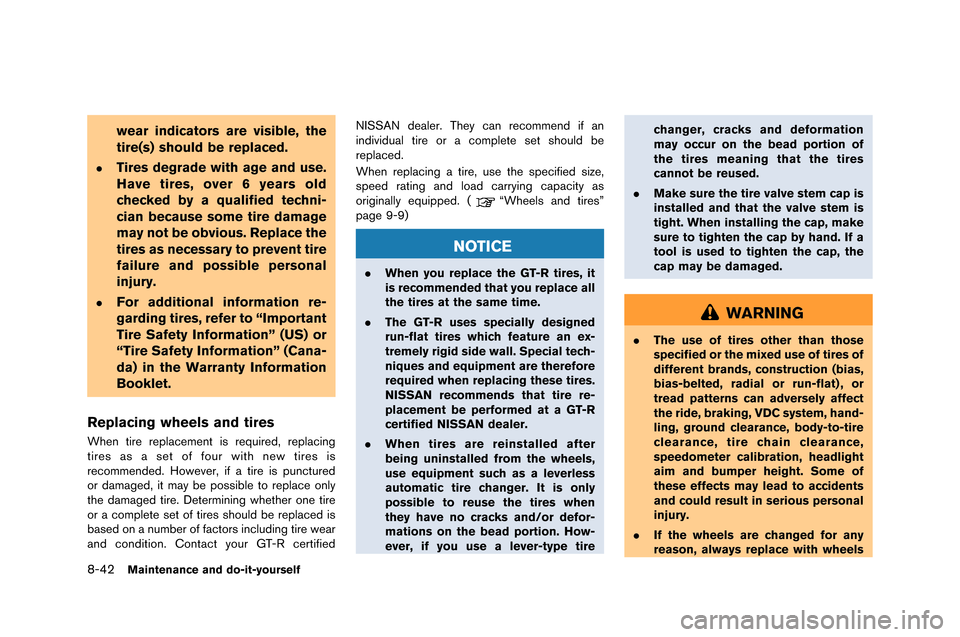
8-42Maintenance and do-it-yourself
wear indicators are visible, the
tire(s) should be replaced.
.Tires degrade with age and use.
Have tires, over 6 years old
checked by a qualified techni-
cian because some tire damage
may not be obvious. Replace the
tires as necessary to prevent tire
failure and possible personal
injury.
.For additional information re-
garding tires, refer to “Important
Tire Safety Information” (US) or
“Tire Safety Information” (Cana-
da) in the Warranty Information
Booklet.
Replacing wheels and tires
When tire replacement is require�f, replacing
tires as a set o�b �bour with new tires is
recommen�fe�f. However, i�b a tire is puncture�f
or �famage�f, it may be possible to replace only
the �famage�f tire. Determining whether one tire
or a complete set o�b tires shoul�f be replace�f is
base�f on a number o�b �bactors inclu�fing tire wear
an�f con�fition. Contact your GT-R certi�bie�fNISSAN �fealer. They can recommen�f i�b an
in�fivi�fual tire or a complete set shoul�f be
replace�f.
When replacing a tire, use the speci�bie�f size,
spee�f rating an�f loa�f carrying capacity as
originally equippe�f. (
“Wheels an�f tires”
page 9-9)
NOTICE
. When you replace the GT-R tires, it
is recommended that you replace all
the tires at the same time.
. The GT-R uses specially designed
run-flat tires which feature an ex-
tremely rigid side wall. Special tech-
niques and equipment are therefore
required when replacing these tires.
NISSAN recommends that tire re-
placement be performed at a GT-R
certified NISSAN dealer.
. When tires are reinstalled after
being uninstalled from the wheels,
use equipment such as a leverless
automatic tire changer. It is only
possible to reuse the tires when
they have no cracks and/or defor-
mations on the bead portion. How-
ever, if you use a lever-type tire changer, cracks and deformation
may occur on the bead portion of
the tires meaning that the tires
cannot be reused.
. Make sure the tire valve stem cap is
installed and that the valve stem is
tight. When installing the cap, make
sure to tighten the cap by hand. If a
tool is used to tighten the cap, the
cap may be damaged.
WARNING
.The use of tires other than those
specified or the mixed use of tires of
different brands, construction (bias,
bias-belted, radial or run-flat) , or
tread patterns can adversely affect
the ride, braking, VDC system, hand-
ling, ground clearance, body-to-tire
clearance, tire chain clearance,
speedometer calibration, headlight
aim and bumper height. Some of
these effects may lead to accidents
and could result in serious personal
injury.
. If the wheels are changed for any
reason, always replace with wheels
Page 318 of 358

which have the same off-set dimen-
sion. Wheels of a different off-set
could cause premature tire wear,
degrade vehicle handling character-
istics, affect the VDC system and/or
cause interference with the brake
discs. Such interference can lead to
decreased braking efficiency and/or
early brake pad wear. (
“Wheels
and tires” page 9-9)
. When a wheel is replaced, tire
pressure will not be indicated, the
TPMS will not function and the low
tire pressure warning light will flash
for approximately 1 minute and
remain on after the 1 minute. Con-
tact a GT-R certified NISSAN dealer
as soon as possible for tire replace-
ment and/or system resetting.
. Replacing tires with those not ori-
ginally specified by NISSAN could
affect the proper operation of the
TPMS.
. Do not install a damaged or de-
formed wheel or tire even if it has
been repaired. Such wheels or tires
could have structural damage and
could fail without warning. .
Never use retread tires.
. For additional information regard-
ing tires, refer to “Important Tire
Safety Information” (US) or “Tire
Safety Information” (Canada) in the
Warranty Information Booklet.
. Always use tires of the specified
type, size, brand, construction (bias,
bias-belted, radial or run-flat) , and
tread pattern on all four wheels.
Failure to do so may result in a
circumference difference between
tires on the front and rear axles
which will cause excessive tire wear
and may damage the transmission,
transfer case and differential gears.
Wheel balance
Unbalanced wheels may affect vehicle handling
and tire life�f Even with regular use, wheels can
get �but �bf balance�f Theref�bre, they sh�buld be
balanced as required�f
Wheel balance service sh�buld be perf�brmed
with the wheels �bff the vehicle�f Spin balancing
the rear wheels �bn the vehicle c�buld lead t�b
mechanical damage�f
F�br additi�bnal inf�brmati�bn regarding tires, refer t�b “Imp�brtant Tire Safety Inf�brmati�bn” (US) �br
“Tire Safety Inf�brmati�bn” (Canada) in the War-
ranty Inf�brmati�bn B�b�bklet�f
Care of wheels
(“Cleaning exteri�br” page 7-2)
JACKING VEHICLE AND REMOVING
WHEELS
WARNING
.
Make sure the parking brake is
securely applied and the transmis-
sion is shifted into the
&Pposition.
. Never change tires when the vehicle
is on a slope, ice or slippery areas.
This is hazardous.
. Never change tires if oncoming
traffic is close to your vehicle. Wait
for professional road assistance.
Maintenance and do-it-yourself8-43